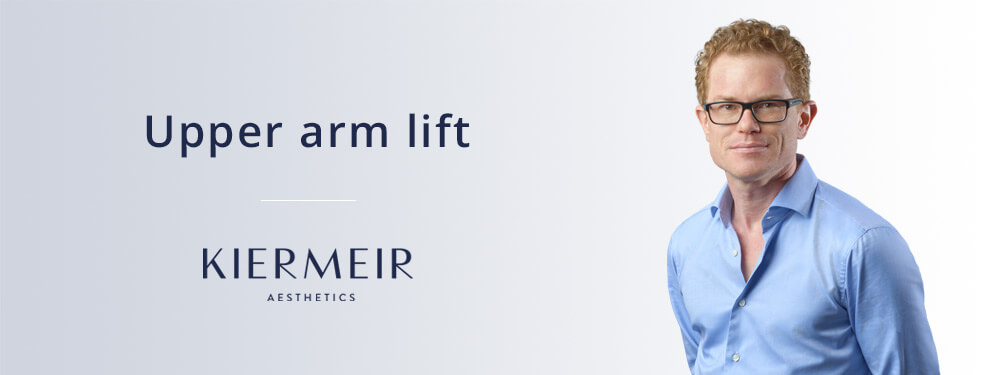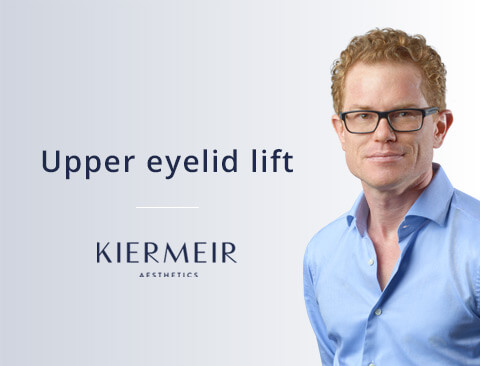Upper arm lift in Bern

Dr. med. David Kiermeir
Specialist for plastic, reconstructive and aesthetic surgery (FMH)
more than 15 years of surgical experience
since 12 years exclusively active in the field of plastic and aesthetic surgery
over 6,000 performed surgeries
Facts on upper arm lifting
| Treatment duration: | approx. 2 hours |
| Anaesthesia: | local or general anaesthetic |
| Hospital stay: | only after treatments with general anaesthetic |
| Removal of sutures: | not necessary |
| Sports: | after a few weeks |
| Costs: | CHF 10.000 |
Loose, flabby upper arms can be very troubling for those affected. As tissues lose their elasticity over time, women in particular are often afflicted by slack, drooping upper arm skin. Many choose to hide their arms under longer clothing as a result, though this flaw also impacts on their self-confidence.
Often mocked as ‘bingo wings’, slackened skin in the upper arm area primarily forms as part of the natural ageing process, though it can also be caused by significant weight loss. However, an upper arm lift can correct this beauty flaw with long-lasting results. The procedure can also smooth out undesirable wrinkles in the skin, leaving the patient’s upper arms looking taut and youthful.
The upper arm lift procedure
In a procedure to lift upper arm skin, Dr Kiermeir removes excess skin and fat tissues to restore an aesthetic, taut form to the patient’s upper arm. He does this in a surgical procedure lasting roughly 2 hours, carried out under local (or, in some cases, general) anaesthetic at our clinic here in Bern. Upper arm lifts performed under general anaesthetic usually require an inpatient stay of several days.
Before the procedure, Dr Kiermeir precisely defines where he will make the incisions during surgery. He maps out where they are to be made on the patient’s skin before the operation begins. Then, at the start of the upper arm lift, Dr Kiermeir makes the requisite incisions in the inside of the patient’s upper arms. In more extensive procedures, it may be necessary to extend incisions up to the armpit or down to the lower arm. However, upper arm lifts are always planned in such a way that resulting scars are as inconspicuous as possible.
In the next step, Dr Kiermeir removes the excess skin and fat tissue. He then sutures the incisions back together and inserts drains to ensure that fluids can drain freely from the wound. After the upper arm lift, the patient is fitted with a special compression bandage.
After the upper arm lift
Following an upper arm lift, the patient needs to wear a specially adapted compression bandage for several weeks. This bandage prevents swelling and ensures that the healing stage is free from complications. It’s also important to cool the treated areas on a regular basis. You should avoid exercise and physical exertion where possible to begin with.
Dr Kiermeir will monitor the treatments results at regular intervals in the first few weeks. This will involve examining how wounds are healing and, after 2–4 days, removing the surgical drains inserted during the operation.
Frequently asked questions on upper arm lifting
Before performing the surgery, Dr Kiermeir holds a personal consultation with each patient in Bern. In this meeting, you’ll be given important instructions on how best to prepare for the upper arm lift. In the case of a procedure under general anaesthetic, for example, you should temporarily stop taking certain medications which could impact on blood coagulation. You should also avoid excessive alcohol and nicotine consumption in the lead up to the upper arm lift. Dr Kiermeir will inform you in person of further preparatory measures and what exactly your procedure will involve.
An upper arm lift performed under general anaesthetic entails the same generic risks as all operations. In general, though, surgery to tauten upper arm skin is a low-risk procedure. In rare cases, complications can include wound healing deficits, embolisms or thromboses. Severe complications with lasting health consequences following upper arm lifts are very rare.
After the upper arm lift, you may experience some pain or a feeling of tightness at first. Depending on the severity of these complaints, you may wish to take painkillers to treat them.
Upper arm lifts always result in some scars, though these usually fade considerably over time. From time to time, patients experience excessive scarring – which can usually be treated very effectively using a range of corrective methods.
CONTACT
Opening hours
| Monday | 8.00 a.m. - 5.00 p.m. |
| Tuesday | 8.00 a.m. - 5.00 p.m. |
| Wednesday | 8.00 a.m. - 5.00 p.m. |
| Thursday | 8.00 a.m. - 5.00 p.m. |
| Friday | 8.00 a.m. - 4.00 p.m. |
and by appointment



